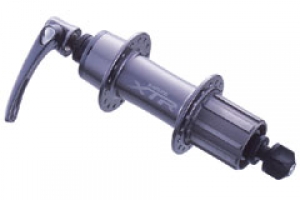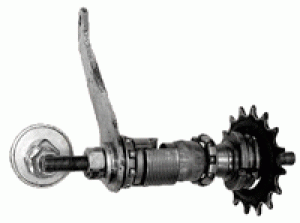How does a bicycle rear wheel carriage work? Bicycle hub axle standards
Good day to all! A very interesting bike came to us for repair the other day! But, to be more precise, it’s not an interesting bike, but what happened to it is interesting. The bike was an old two-suspension Ukrainian-made Ardis.
What happened to him?
Yes, everything is simple, according to the owner, “After leaving the curb, I felt the wheel began to wag a lot!”. Indeed, the rear wheel staggered to impossibility. What did we start doing? Got it, two keys and go!
What keys to use in order to disassemble the bike axle? We used two wrenches - an adjustable wrench and a standard open-end wrench for 15. Look at the following photos of the open-end wrench. This is a standard wrench from a 14-inch bike set. It is convenient because it is thin and it is practical for them to adjust the bearing clearance. What we did was cut it a little to a size of 15 mm. But not the whole length, but only one centimeter. It turned out the key for 14 and 15. Very convenient, plus weight savings in the bag.
So, we're filming. Some wheels are mounted on eccentrics, and some on bolts. Our client was on the bolts, unscrewed the bolts, carefully bent the caliper and removed the wheel.
And what happened to us?
The axle of the bike broke. Just burst! This is called "metal fatigue", which sooner or later comes to everyone. The bottom line is that the bike is about 10 years old and has been used day in and day out. So the moment has come when a true friend needs repair.
Well, they took out the axle, wiped it and went to buy a new one. The price of a new axle is $1.50. The kit includes the axle itself, the left and right cone, locknuts and clamping nuts. What makes it different from the native one is that it is in cones that press the bearing. If one cone has a metal boot on the bike’s native axle and the other does not, then there are no anthers in the new axle at all.
This is bad, because a boot is simply needed on the side of the brake disc to prevent dust from entering and significantly extend the life of an already new bushing. What to do? You can look for a cone with an anther, or make an anther yourself - which is what we did!
Carefully knock the boot off the old cone. Yes, we replace the cones, as they have obvious signs of wear. If the cones have even "treadmills", you can also put relatives. But, we do everything qualitatively, which is why we began to change the anther. We put the cone in a tesk, twist the old axis into a cone by a centimeter, no less, and gently hit it with a hammer several times from above.
The boot has been removed, but this is only the first step.
To press the boot on a new cone, it is forbidden to put the cone, as shown in the following photo. The whole point is that in this way the anther will quickly bend and not crawl through, and if you turn the cone on the other side, the inlet diameter is an order of magnitude smaller and the anther easily sits down.
You need to put it on not to the end of the cone, but leave about 1 mm, no more and no less. Be careful, because the boot is easy to bend and hard to align.
Well, everything is ready, it remains to lubricate everything with grease - we used a CV joint. The principle by which we add lubricants to bearings is that the more, the excess will come out. The main thing after assembly is to gently wipe everything with a rag.
During the installation process, we noticed a marriage of the axis - one tip is slightly bent. That is, the axis is not straight, but slightly curved. Fortunately, the axle flex is small and on the edge, which did not affect the operation of the bearings and the adjustment of the axle. By the way, we already wrote about that and added photos.
Conclusion - before buying an axle, it is worth checking its straightness, the integrity of the axle and the quality of the anthers.
And yet, why anthers should not be on both sides? Yes, because one side - the bearings are behind the ratchet, that is, they are hidden from dust and water. In addition, often the anther simply does not fit into the ratchet hole.
Thank you all for your attention, subscribe to the newsletter, write your questions in the comments!
The length of the hub axle is determined by the Over - Locknut - Dimension (OLD) parameter. This parameter defines the distance between the outer nuts on the axle. It is equal to the distance between the fork dropouts or chainstays of the rear triangle of the frame.
- 9 x 100 mm - used on most modern bicycles. The obsolete version with nuts or the most popular with eccentric clamping;
- 15 x 110 mm - hollow plug-in with eccentric clamp, used for cross-country bikes or trail;
- 20 x 110 mm - hollow plug-in, mounted on bicycles for extreme cycling. The eccentric version is quickly removed and installed. For heavy loads in extreme disciplines, a bolt-on option is used;
- 10 x 135 mm - large size for fat bikes.
The large diameter of the hub axle provides high rigidity and strength of the wheel-fork connection, although this increases the weight of the entire hub. A wheel with a plug-in axle is mounted and removed longer than usual. Separate hollow axle hubs can be compatible with conventional forks using an adapter.
Rear hub axle standards
- 10 x 130 mm - road bikes;
- 10 x 135 mm - the vast majority of modern bicycles;
- 10 x 120 mm - bikes for racing on the track;
- 12 x 150 mm - downhill and bicycles for various extreme sports;
- 10 x 170 mm - for fat - bikes.
As a rule, the rear hubs are asymmetric, since the cassette or rear star is located on the right side. Because of this, the right flange of the rear hub is located closer to the middle of the hub, so the spokes on the right side are 1-2 mm shorter than the spokes on the left side.
Also read on this topic:
The bicycle wheel takes on the loads that arise during the operation of this vehicle. The purpose of the wheel is to support the weight of the cyclist and the entire structure of the bike and to cope with shock loads that arise from ...
On different types Bicycles are equipped with rims with various designs, but the vast majority are rims of the so-called box section. They are designed for tires with a bead on the edges. In the rim…
Full size bicycle wheel is the diameter of the rim, plus the thickness of the bicycle tire. The unit of measurement for the diameter of a bicycle wheel is the English inch. Now there are six most common sizes of bicycle wheels ...
Double-sided hub (Flip-Flop) - a hub that is designed to quickly change the type of drive and transmission ratio by shifting the bicycle wheel 180 ° along its axis. It is threaded on both sides and allows you to install…
For mountain bikes, cassettes are made with a set of stars from 11-28T to 11-36T for 8-10 stars. For road from 11 (12) -22T to 11 (12) -27T for 8 - 11 stars. Campagnolo mountain cassettes are compatible with road cassettes with the same number of chainrings…
Of course, to care for a bike, you need to understand how it works. Of course, in the structure of the iron horse there is a lot that is complex and incomprehensible at first glance, but this is no reason to turn a blind eye to it. Bicycles need to be looked at from different angles. Today we will not talk about the whole bike as a whole, but we will focus on what is in the area rear wheel bicycle, in particular, on the axle.
Peculiarities
The rear axle of the wheel is fixed and is located in a special movable bushing of the same wheel. Just such bushings provide wheel movement, and they do this thanks to a fixed axle. In order to better understand where the rear axle is located, we note that it is next to it that the spokes are already attached. If something happens to the cones, bushings or rear axle, you will have to disassemble and repair the entire mechanism rear wheel. Therefore, it is extremely important to ensure that everything related to the rear axle remains safe and sound.
Repair

Of course, there are situations when something in the axis breaks. Fortunately, such situations are not hopeless. If something is broken, and you still do not understand which side to turn the necessary nut and where to put the cones, the Internet will help. And we, in turn, will help you navigate the difficult task of repair.
What should be taken into account when repairing?
- First of all, you need to understand that everything related to the rear bicycle axle is a very delicate matter, which means that it must be approached carefully so as not to make things worse.
- It is important not to lose even a single small detail. Even if you lose a small nut or cone, it will be difficult for you to complete the axle repair without them.
- The first step is to remove the rear axle bicycle hubs, as well as a block with asterisks. Of course, when removing it, it is better to put the bike on the side where this block does not exist.
- After you remove the rear sprocket assembly, you will need to remove the bearing race as well.
- There must be order in everything, you can see for yourself when, after disassembling and removing, a bunch of small details will appear in front of you. Therefore, it is important for the crane that every little thing has its own place.

But all this is only a preparatory stage in the repair of the rear axle, because the most difficult is still ahead. After you put all the details in order, and nuts, cones, etc., as for the bushings, will not be scattered in different directions, you will also need to remove the bushing screw.
Then the sleeve will need to be cleaned and all its components carefully checked. This will facilitate the process of further lubrication, which takes place in two stages. This matter should also be treated as responsibly as possible, because taking care of the axis is an art, and it does not tolerate haste. Before inserting the bushing into place, you need to return the bearings to their places. Then you can gradually return each part to its place. This is how the assembly process ends, and with it the repair process.
Summing up, we can say that such a key component of the bike as the rear axle deserves to be taken care of. Don't be afraid of it complex process, after the first time it will no longer seem so difficult.
Tag Cloud:
Chinese rear hub bicycle
